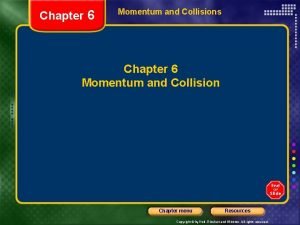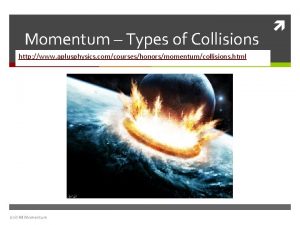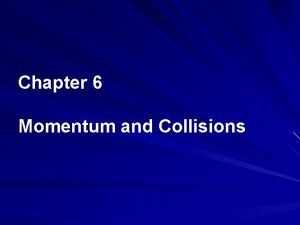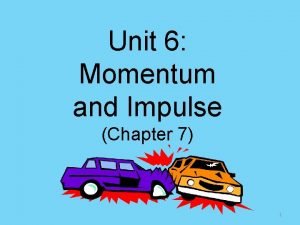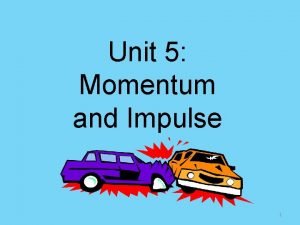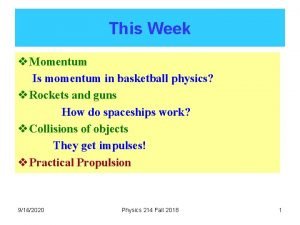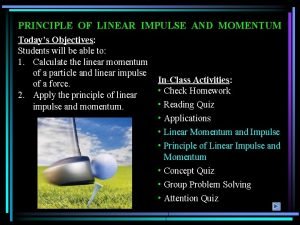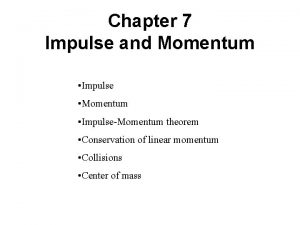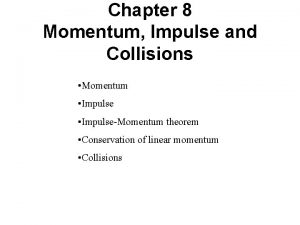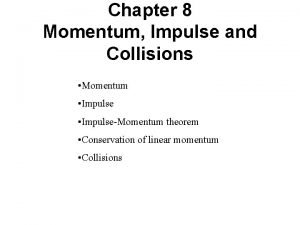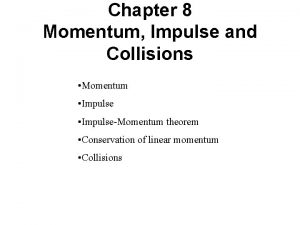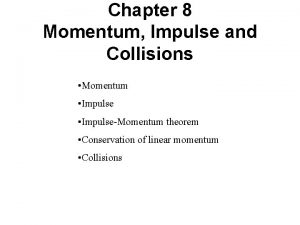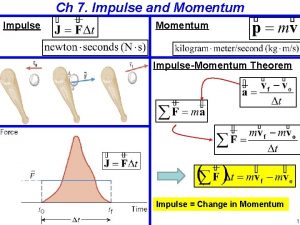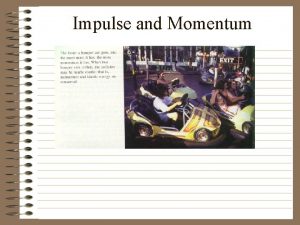Chapter 8 Momentum Impulse and Collisions Momentum ImpulseMomentum












- Slides: 12

Chapter 8 Momentum, Impulse and Collisions • Momentum • Impulse-Momentum theorem • Conservation of linear momentum • Collisions

Momentum, p The linear momentum p of an object is the product of the object’s mass m and velocity v: Linear momentum is a vector quantity that points in the same direction as the velocity. SI Unit of Linear Momentum: kilogram · meter/second = (kg · m/s)

Impulse, J The impulse J of a force is the product of the average force and the time interval Dt during which the force acts: Impulse is a vector quantity and has the same direction as the average force. SI Unit of Impulse: newton · second = (N · s) = kg. m/s Impulse and momentum, both have the same unit.

IMPULSE–MOMENTUM THEOREM When a net force acts on an object, the impulse of the net force is equal to the change in momentum of the object:

Impulse and Momentum in Sports Impulse and momentum play important roles in sports.

Hitting a baseball

Hailstones Versus Raindrops Unlike rain, hail usually does not come to rest after striking a surface. Instead, the hailstones bounce off the roof of the car. If hail fell instead of rain, would the force on the roof be smaller than, equal to, or greater? Answer: Greater

Definitions of Terms Internal forces Forces that the objects within the system exert on each other. External forces Forces exerted on the objects by agents that are external to the system. An isolated system is one for which the vector sum of the external forces acting on the system is zero.

8. 3 The Principle of Conservation of Linear Momentum The total linear momentum of an isolated system remains constant (is conserved).

Collisions are often classified according to whether the total kinetic energy changes during the collision: 1. Elastic collision—One in which the total kinetic energy of the system after the collision is equal to the total kinetic energy before the collision. 2. Inelastic collision—One in which the total kinetic energy of the system is not the same before and after the collision; if the objects stick together after colliding, the collision is said to be completely inelastic.


Collisions in One Dimension 1. Apply the conservation of momentum. 2. If the collision is elastic, apply the conservation of energy.
 Chapter 6 momentum
Chapter 6 momentum Aplusphysics momentum-impulse answer key
Aplusphysics momentum-impulse answer key A 1850 kg luxury sedan stopped
A 1850 kg luxury sedan stopped Momentum and collisions review
Momentum and collisions review Perfectly elastic collision
Perfectly elastic collision Momentum is conserved in all collisions
Momentum is conserved in all collisions Physics 03-02 potential energy and conservative forces
Physics 03-02 potential energy and conservative forces Unit 6 momentum and impulse
Unit 6 momentum and impulse Units of momentum
Units of momentum Momentum in basketball physics
Momentum in basketball physics Linear impulse momentum equation
Linear impulse momentum equation Linear momentum and linear impulse
Linear momentum and linear impulse Importance of momentum and impulse
Importance of momentum and impulse
